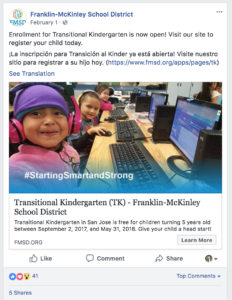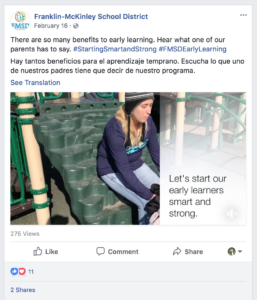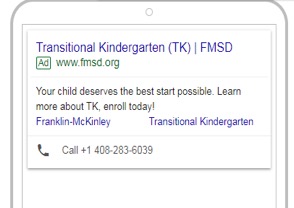Going Small Can Pay Off Big: 3 Simple Steps for Your Social Media Campaign
Posted by Julie Malmberg Grawe on April 16th, 2018
Posted in Blog, Social Media

While the importance of having a social media presence is relatively well understood, pinpointing the how, where, how much, why, and for whom can be paralyzing for small nonprofit organizations and school communications teams strapped for resources and time. At Mission Minded, we see this all too often, which is why we’ve developed a simple and effective approach to making sure your social media campaigns work for your organization.
But before we dive into the formula, let’s first agree on the why.
According to the 2018 Global NGO Technology Report, 95% of non-governmental organizations (NGOs) state that social media is effective for brand awareness, and 71% agree that social media is effective for online fundraising. In addition, social media, at its core, is free. So why ignore a free platform that could be effective in helping you reach your goals, whether to increase admission applications or boost donations? Even if you only commit to one social media campaign a year, you can generate buzz, and, more importantly, action.
So now that you’re convinced of the why, let’s get to the specifics of how to run a simple, effective school and nonprofit social media campaign.

1. Outline Your Campaign Goal(s)
A social media campaign without a goal is like cooking without a recipe—it might turn out okay, but chances are you’ll miss out on something that could have been great, not just good enough. For effective social media campaigns, it’s important to be specific about what goal or goals you want to achieve.
Mission Minded teamed up with Brandeis School of San Francisco this past admissions season and helped define two goals for their social media: 1. Leverage digital channels to drive more traffic to their site; 2. Increase admissions inquiries. Through Facebook and Google ads, traffic to key admissions pages on Brandeis’ website increased by 170%.

2. Define your audience(s)
It sounds intuitive, but this step is something far too many organizations overlook. If you’re trying to speak to everyone through your school or organization’s Facebook or Instagram accounts, then you risk speaking to no one. Mission Minded led Franklin-McKinley School District through a social media campaign to help attract families to transitional kindergarten (TK) during the summer of 2017. We determined two audiences were key to accomplishing their goal of increasing TK enrollment: parents of current students in their district who would be strong ambassadors of TK, and parents of kids eligible for TK.
While their social media campaign certainly attracted interest from others outside of those two core audiences, by narrowly defining the audiences most key to reaching their goals, we could better determine what messages to send, where to run the campaign and for how long.
With this focus, the campaign was a huge success and all of the available TK slots were filled by grateful parents.

3. Keep It Simple, Be Consistent, and Be Present
Don’t try to run a marathon before you can run a 5K. What that means for most schools and nonprofits is that you don’t need to try to be on every single platform right from the start. Pick 1-2 based on your audience(s) and create a campaign on each that includes a variety of posts, paid advertisements, images, videos, and interaction.
In Franklin-McKinley School District’s TK campaign for 2018, they focused on Facebook, rather than Facebook and Twitter. As a result, they had a 300% increase in engagement as marked by new “likes” (learn more about engagement in The Beginner’s Guide to Social Media Metrics: Engagement by HootSuite). Franklin-McKinley School District responded to comments on posts, boosted events, and included an array of visuals to draw attention.
Because they were so effective with their organic posts and messaging, Mission Minded was able to reduce Facebook Ad spend. Net—Franklin-McKinley School District was more effective with less cost! Had they spread out their efforts over less-effective social media channels, they could have jeopardized their success on Facebook. Picking just one channel allowed them to be fully present and effective, something their key audiences awarded them with through their engagement.
With the simple social media campaign formula outlined above, social media campaigns can be your ticket to achieving your organization’s goals. Should you feel stuck or uncertain how to proceed, Mission Minded’s Digital Team is standing by to coach, cheer you on, or lead you through an effective social media campaign and more. Need more information to get your marketing started today? Download our 10 Tips for Effectively Marketing Your School.
Stay tuned for a future post on the importance—and effectiveness—of Google Ads and Facebook Ads. Whether you have a $300 or a $3,000 budget, nonprofit organizations and schools can lead powerful Google and Facebook ad campaigns that increase awareness and help you achieve your goals.

Julie Malmberg Grawe is Director of Digital and a Senior Brand Strategist based in Denver with diverse experience working in the nonprofit, foundation, and corporate sectors.
See all posts by Julie Malmberg Grawe